Looking for the ultimate Italian drinks guide? Look no further!
When visiting Italy, it’s easy to get lost in the incredible history, food, culture, and landmarks of Italy. But, an often-overlooked element is the fantastic array of drinks in Italy that you simply have to try out!
In this definitive guide on drinks from Italy, we’ll outline the 23 most famous Italian drinks and beverages that you simply have to give a go when visiting Italy. Ranging from cocktails to spirits, to wines, to strong Italian liquor as well as non-alcoholic Italian drinks too, we’ve got you covered in this Italy drinks guide!
So, Let’s raise our glasses, and as the Italians say, ‘Cin Cin’!
Disclaimer: This post contains links to services or products that I trust and recommend and from which I may earn commissions. Read our privacy policy for more.
| Before you go, be sure to plan & book your trip! | |||
 | Browse & Book Hotels |  | Browse & Book Car Rentals |
 | Browse & Book Flights |  | Browse & Book Buses and Trains |
Pssst…Have you packed all your essentials? Make sure to read our European packing list post to ensure you’ve ticked all the packing necessities off your list!
Italian Cocktails
Aperol Spritz
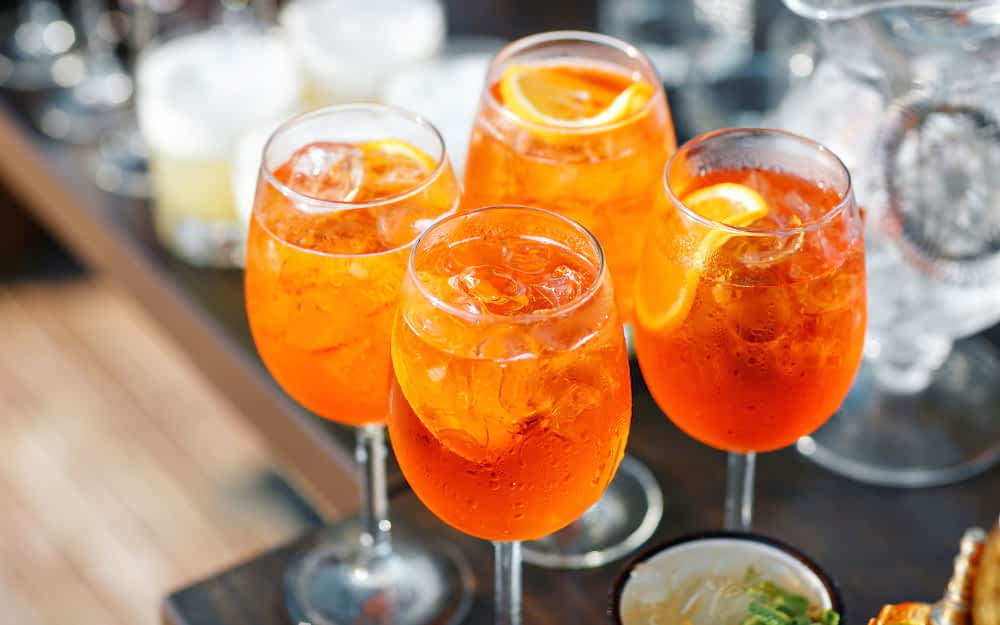
By Jess from Jagsetter
The Aperol Spritz is a refreshing Italian cocktail made with Prosecco, Aperol, soda water, and ice. Sometimes, a slice of orange is added for a little extra zest. The Aperol spritz is known as a pre-dinner drink in Italy and is often served with light snacks such as popcorn. While it’s traditionally paired with appetizers, it’s become so popular that it’s acceptable to drink it at any time of day.
The nascent origins of the drink are traced to the Veneto region of Northern Italy in the 1800s—when the concept of the Spritz began. Italian’s wanted to make their wine less potent—so they spritzed their wines with water. In time, the recipe evolved as Italian’s tested different ingredients to make it more palatable. By the 1900s, it became the Aperol Spritz that Italian’s know and love today.
Now, the drink is an Italian staple and can be ordered in almost every bar & restaurant in the country. The drinks’ popularity has evolved so much that it’s available on a global scale. I’m a huge Aperol Spritz fan and first tried it in Italy, but seek it out everywhere I go now and even try to make them at home.
Bellini
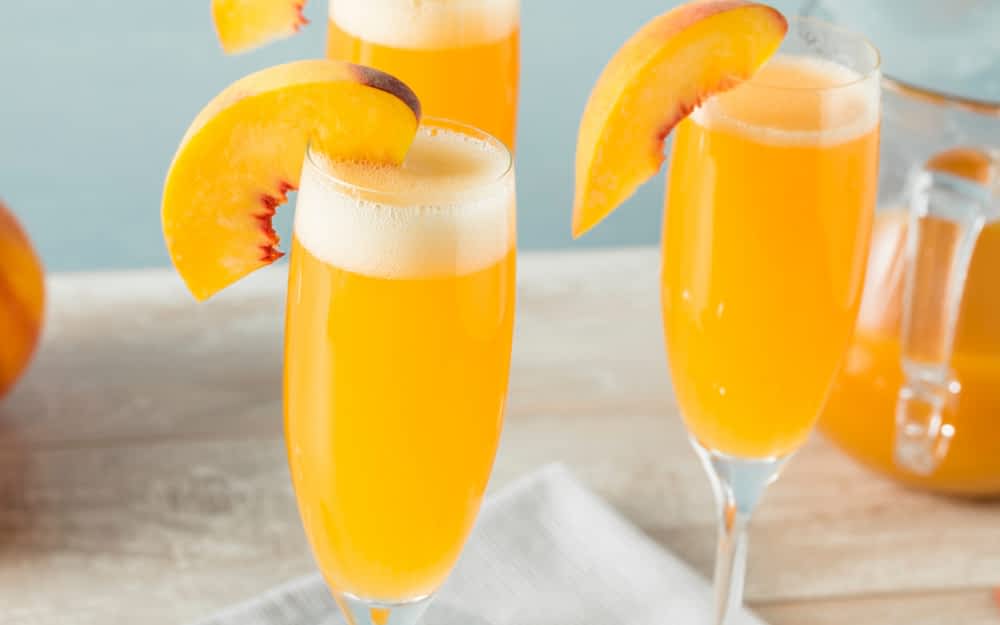
By Jessie Moore of Pocket Wanderings
A refreshing Bellini is the perfect Italian cocktail for a warm summer day. The Bellini was invented between the 1930s and 1940s by Giuseppe – the chef who also invented the raw beef dish of carpaccio. It was inspired by Venetian painter Giovanni Bellini and was first created in the infamous Harry’s Bar of Venice. So when you are next visiting Venice, be sure to stop by to enjoy a classic Bellini cocktail where it all started. You won’t be able to snap a picture though, as photos are not allowed in order to maintain the privacy of the bar’s discerning visitors.
A sweet and fruity cocktail, it is made from just two ingredients: peach purée and Prosecco, an Italian sparkling wine. Due to its simplicity, the quality of the Bellini relies heavily on the quality of the ingredients. During the summer months, fresh ripe peaches should be used for the purée. Out of season, high-quality frozen peach purée will do the trick. Finally, a good dry Prosecco is best used. For a little extra flavour and a dash of rich pink, you can also add a little dash of raspberry purée.
Bombardino
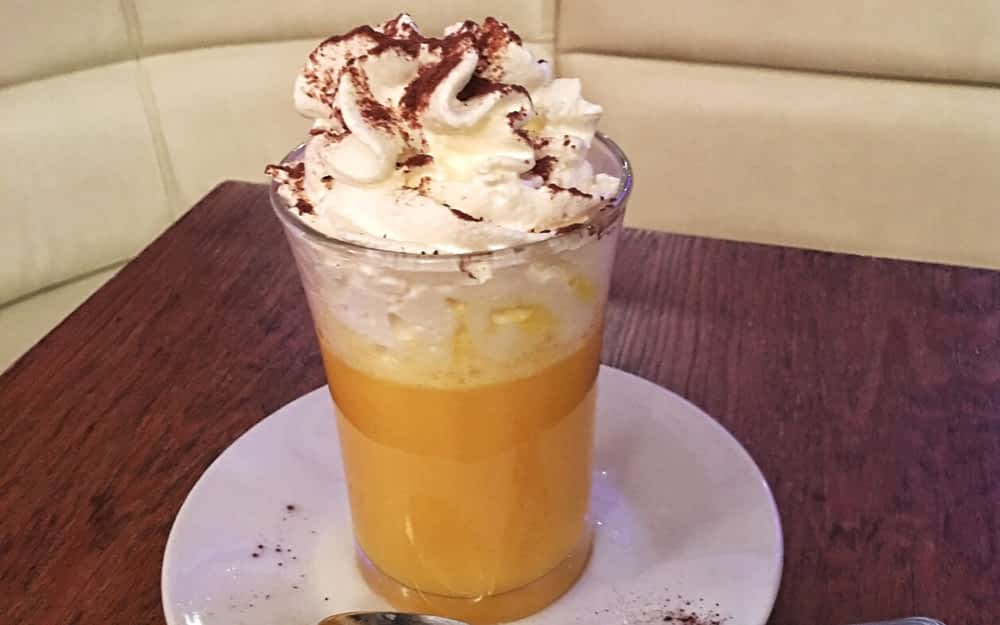
By Veronika from Travel Geekery
If you’ve recently paid a visit to one of the European ski resorts, you have surely come across Bombardino. The typical Italian winter cocktail originated in northern Lombardia and has become widespread on the slopes of Austria, France or even the Czech Republic.
Bombardino is primarily warm eggnog topped off with whipped cream and sprinkled with cinnamon. There’s usually some extra alcohol added – typically a brandy.
It’s best enjoyed on a slope in the Italian Alps, especially after a few rides got your blood pumping.
You can easily make Bombardino at home if you’re stocked up on eggnog, but be careful with the heating process – eggnog contains raw eggs and you can imagine what a mess it would create if you boiled it.
There’s a legend connected to the origin of Bombardino. A young Genovese man moved to the Italian Alps and eventually opened a ski lodge. When one day a group of skiers unexpectedly showed up from a blizzard, he quickly put together a warm drink from ingredients he had at hand. One of the customers exclaimed “what a bomb” that drink was – and from that, the name Bombardino was born. The drink quickly grew in popularity and the rest is history.
Campari & Soda
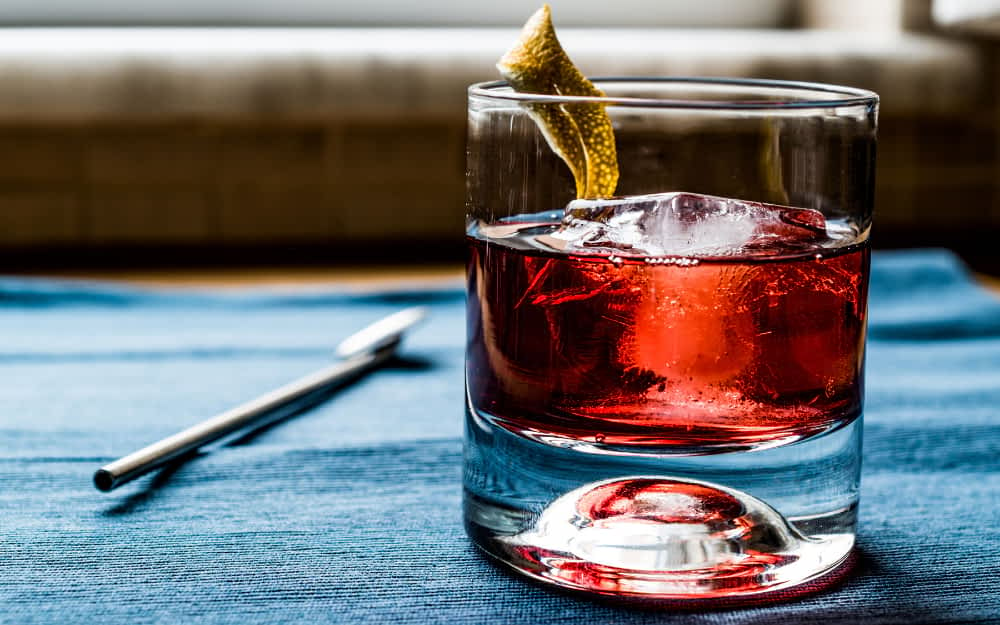
By Nicole from Go Far Grow Close
Campari is a bright red bitter alcohol that was invented in 1860 by Gaspare Campari in Novara, Italy. It was originally coloured with carmine dye which is derived from crushed cochineal insects and this gave the drink its distinctive red colour. Carmine dye is no longer used today, although Campari only stopped using it in 2006 after pressure from various groups.
No one knows the exact ingredients of Campari. They are a closely held secret. However, it is marked by underlying flavours of cherry, cascarilla, clove, rhubarb, cinnamon and orange peel.
Campari and bubbly soda water is widely viewed as a wonderful aperitif, a drink served before a meal or at cocktail hour. Its bitter flavour and clean finish are said to stimulate the appetite.
Today, not only is Campari and soda one of the most recognized cocktails in the world, but Campari has also become the key ingredient in another famous Italian drink – the negroni. The negroni was Invented in 1919 by Count Negroni – who asked to add a touch of gin rather than soda to his drink.
Hugo Spritz
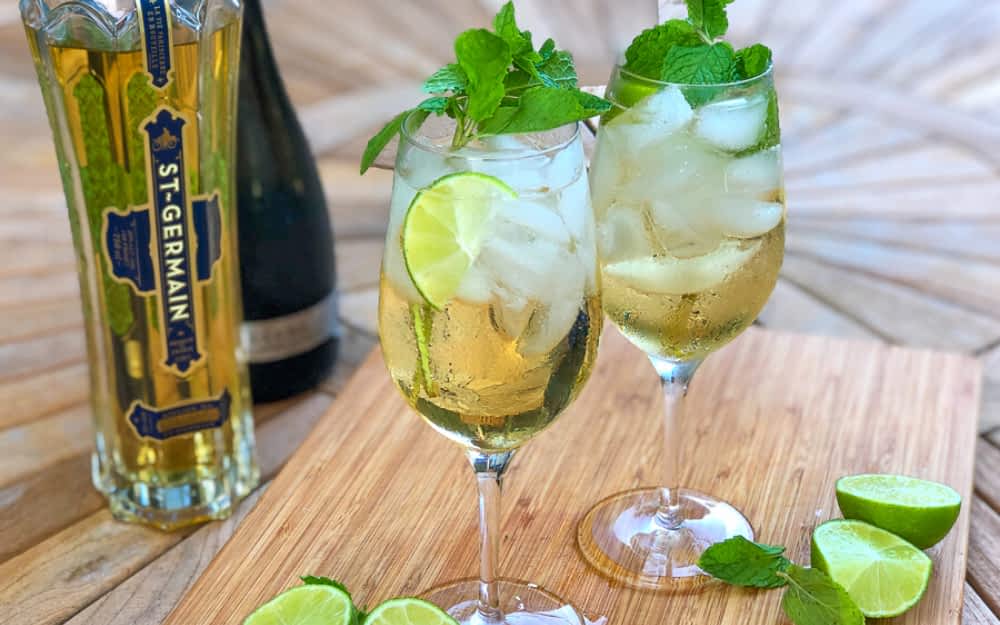
By Lori from Italy Foodies
When you find yourself parched from sampling the amazing food in northern Italy and looking for a refreshing Spritz alternative, try a light and delicious Hugo Spritz. This traditional speciality drink is low in alcohol with just the right touch of floral sweetness.
Originally, the syrupy base of a Hugo Spritz was made from lemon balm (a herb in the mint family) but the essence of a local flower replaced it. Today, the drink is crafted with elderflower liqueur made from the white blossoms of the elderberry tree (St. Germain is the most famous brand used). Locally made Prosecco is then added, whose grapes are grown extensively throughout the Veneto. Add in a bit of Seltzer or club soda to top off the drink to help maintain the frizzante nature of the prosecco, and you have quite an Italian refreshment. The standard garnish is a sprig of fresh mint leaves.
Considered an aperitivo enjoyed before a meal, the Hugo Spritz is served as an alternative to the popular orange liqueur-based Aperol Spritz, aka Spritz Veneziano, a drink found throughout Italy.
If you enjoy a good spritz cocktail, try Hugo Spritz the next time you visit Italy.
Negroni

By Marco from Travel-Boo
Next up on our list of top Italian alcoholic drinks is one that’s not for the fainthearted. The much-loved Negroni cocktail is almost purely alcoholic in nature. It was said to have originated back in 1919 at the Caffe Casoni in Florence. Here, Count Camillo Negroni reportedly asked the bartender to change up his favourite cocktail, the Forsco Scarselli, by substituting soda water with gin.
The popular Negroni is usually made by combining one part vermouth (Rosso), one part gin and part Campari and then topped off with an orange peel as garnish.
Having seen a surge in popularity, many companies have even gone as far as producing ready-to-drink versions of this popular Italian drink, such as the Antico Negroni 1919 version.
Popular Italian Wines
Barolo

By Annabel from Smudged Postcard
The red wine Barolo is produced in the northern Italian region of Piedmont. It is made from the grape variety Nebbiolo which is grown across the Langhe wine area south of Turin. However, the grapes which go into bottles of Barolo are only grown in a small area on the hillsides around the village of the same name.
Barolo goes well with truffles – another feature of Piedmont cuisine. The wine also works really well with red meat and strong cheeses.
The tiny village of Barolo is well worth visiting – there you’ll find a small corkscrew museum and several restaurants and wine bars and it’s a great spot to enjoy lunch.
Barolo is a rich, fruity red wine, aged for a minimum of three years. The wine doesn’t come cheap but it’s worth every penny. If your budget won’t stretch to a bottle of Barolo, another good quality Nebbiolo wine from Piedmont which is well worth trying is Barbaresco.
Brunello di Montalcino

By Isabelle from Cultured Voyages
Brunello di Montalcino is a very special wine. Produced in the area that surrounds the town of Montalcino in Tuscany, a stop to try some of this very delicious Italian drink is a must when in the region on a Tuscan road trip. Falling more on the exclusive, expensive side of the pricing scale, this fantastic red wine justifies its price tag with a product that many wine critics cite as being Italy’s best wine.
Made from 100% Sangiovese grapes, this wine boasts Italy’s highest DOGC classification. DOGC stands for “Denomination of Controlled and Guaranteed Origin”, which is a government classification that indicates Italian wine of the highest standards.
In terms of taste, Brunello di Montalcino is a bold, full-bodied wine. A younger Brunello is a little more tart, with earthy, fruity notes. When given time to age, these tart notes become sweeter and earthy tones are replaced with smoother, more leathery ones.
A Brunello with a ‘Normale’ classification will have been aged for 5 years, while a ‘Riserva’ will have been aged for 6. A Brunello di Montalcino will really come into its own, however, after 10 years of ageing – so have a little patience before uncorking that bottle!
Cannonau Wine

By Claudia From Strictly Sardinia
Unknown to most outside of Italy, Sardinian wines are actually excellent.
Sardinian Cannonau wine – which you may know as Grenache – is one of the endemic grapes of Sardinia (not to mention the most planted one), and one of its most popular red wines – to the point that it is said that about a fifth of the bottles of wine in Sardinia is of Cannonau.
The best Cannonau production is said to be in eastern and southern Sardinia, in the provinces of Cagliari and in Ogliastra, and Nuoro.
This is a rich, full-bodied wine, with spicy hints, low acidity and high in alcohol. Though most wineries have their own Cannonau wine, there are a few you simply can’t miss if you ever visit the island. Pala, a winery in the small village of Serdiana, makes its own excellent one; as well as Contini.
Yet, the best Cannonau in the island is the Nepente di Oliena, known for being one of Gabriele d’Annunzio (Italian poet, journalist and soldier during WWI) favourite wines.
Chianti wine

By Roxanne from Faraway Worlds
If you’ve ever enjoyed a dry Italian red wine, it’s probably Chianti. Produced in the largest wine-producing region in Italy, Chianti is the most famous wine in Tuscany. Chianti is made primarily from the Sangiovese grapes originally grown in the area. Only wine made in the Chianti region and containing at least 70% Sangiovese grapes is allowed to be called Chianti.
Chianti is rated according to the percentage of Sangiovese grapes used and how long the wine has aged for. The label on the wine bottle will indicate how the wine has been rated. The DOC or DOCG labels in particular guarantee that the wine has been made in the traditional way using the original grapes in Chianti. In short, it’s a guarantee of quality, although there are many excellent (and often more expensive) wines without those labels.
Historically, Chianti came in a squat bottle contained in a straw basket called a fiasco. Now, however, that’s less common, with most Chianti producers using standard wine bottles. Regardless of the bottle, enjoying a long lunch while sipping a glass of Chianti is the perfect way to spend an afternoon in Tuscany, all while sampling one of the best Italian wines!
Lambrusco
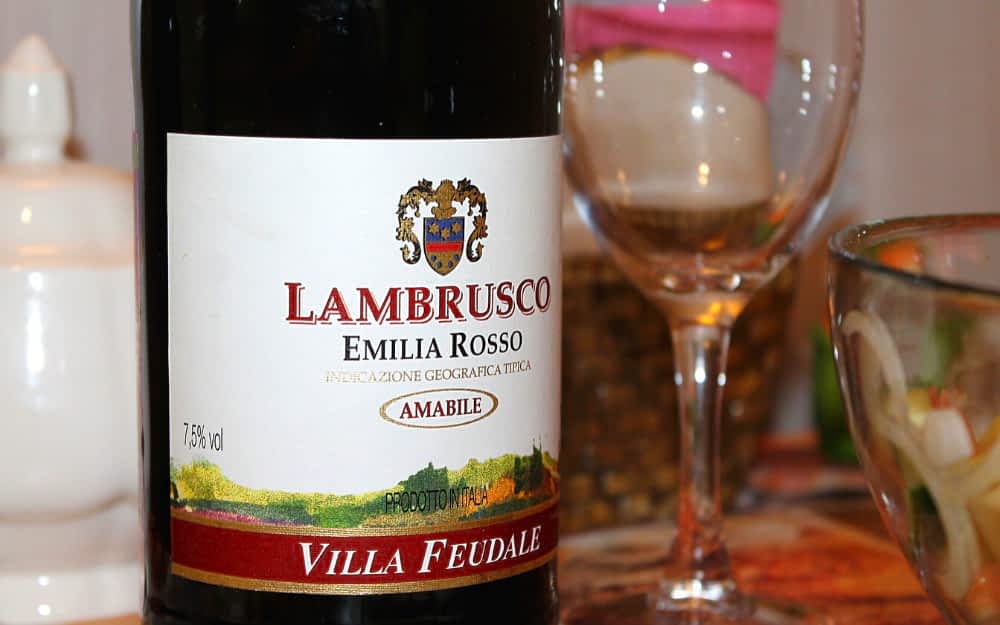
By Jade from The Migrant Yogi
Lambrusco is an effervescent (frizzante) red wine that is primarily produced in the Emilia-Romagna region of Italy. It is also the name of the grape varietal that is used in production. The Lambrusco grape has a long history of being cultivated for wine, dating as far back as the Etruscans. It was renowned for its high yield and versatility.
The wine is quite popular and comes in a variety of styles, varying from very dry (secco) to sweet (dolce). While the grape itself is not naturally sweet, the level of sweetness is adjusted by varying the amount of fermentation or adding sweet grape must.
The effervescent quality of Lambrusco comes from a second fermentation that takes place in a pressurized tank – in the style of Charmat.
While many people visiting Italy will opt for more traditional wine tastings while in the Bel Paese, why not schedule a Lambrusco tasting for a truly unique experience to have in Italy? Try the varying degrees of sweetness and effervescence and see what you like best! Lambrusco makes for the perfect addition to spring picnic and an assortment of salumi!
Negretto Wine

By Allison from Eternal Arrival
For a little-known but absolutely delicious and good Italian wine that you simply have to try during your stay in Italy, keep an eye out for the elusive but tasty Negretto wine. This indigenous grape varietal was rescued from near-extinction by passionate winemakers in the Emilia-Romagna region who believed in its power to express terroir and create powerful, delicate wines.
Whereas many winemakers shifted to more internationally-recognized varietals — Cabernet Sauvignon, Pinot Noir, Pinot Grigio, etc. — a handful of dedicated growers are dedicated to preserving the rich oenological history of Italy’s 2,000+ native wine grapes.
Many of those wines are rather a niche and hard to find (only 400 of those grape varietals are produced in any significant volume), but if you are visiting Bologna, Italy you’ll likely be able to find some winemakers still vinifying Negretto in small quantities.
If you can find a Negretto made by the winemaker Erioli, pounce on it! His wines are delicate, with chocolate, blackberry, and olive notes all with a lovely, light structure. He also makes a delicious white wine from Alionzo grapes (pictured) that is another rare varietal.
Primitivo wine from Puglia

By Anda Travel For A While
Each region in Italy produces local wines, but the wines from southern Italy have come to attention more recently.
The Primitivo grape from the Apulia region in southern Italy takes its name from its early-ripening, it isn’t ‘primitive’ as it might sound.
Primitivo grapes make a strong-bodied wine. The wines are a dark ruby shade, with a fruity and spicy flavour. They also have a high alcohol content and a lot of tannins. Another advantage is the price, as they are still pretty inexpensive.
The wine goes well with steaks or lamb dishes. It isn’t uncommon to have a glass of Primitivo before dinner with a plate of cured meats or local cheeses. Having a glass of wine during la passeggiata is one of the best things to do in Lecce and the rest of the Salento area.
Find a good table outside around sunset, when the locals start their evening stroll before dinner. Order a glass of local Primitivo and a plate of local specialities to share, and prepare for the Italian show of the world walking by. It’s a great start to your evening.
Prosecco

By Enzo from Inguaribile Viaggiatore
Prosecco is a typical Italian white wine. It is mainly produced with the Charmat method and has an effervescence that is diversified into two types: still prosecco and sparkling prosecco.
The name “prosecco” indicates a DOC alcoholic drink originating in the area between Veneto and Friuli Venezia Giulia. Among all, some prosecco is particularly renowned and have achieved the DOCG quality mark (DOC Garantita); the best known undoubtedly being the Prosecco di Conegliano-Valdobbiadene.
Prosecco is made from white grapes belonging to the vine of the same name (Prosecco precisely), now better defined as Glera; this denomination was introduced in 2009, so as not to confuse the grape variety and the wine, while better protecting the DOCG brand of Prosecco di Conegliano-Valdobbiadene.
In reality, those of Glera MUST make up at least 85% of the total grapes, while the remaining 15% can be made up of chardonnay, pinot grigio, verdiso, bianchetta trevigiana and other strictly regulated grapes.
The Prosecco grape is native to the Veneto and Friuli Venezia Giulia; it grows luxuriantly in the provinces of Treviso, Belluno, Venice, Padua and Vicenza.
Prosecco (Glera) has been cultivated for over 200 years and was mentioned (in 1772) in the eighth volume of the “Giornale d’Italia” by the famous academic journalist Francesco Maria Malvolti.
Since 2019 the hills of Prosecco have also been included in the UNESCO World Heritage List.
Vin Brûlè

By Helga from ShegoWandering
The Vin Brulé is present around Italy, as also in Europe on the alternative name of “mulled wine”. Each territory has its own story and its own recipe for this drink. The Vin Brulé originates from Faenza, where every January there’s a tradition called the “Nott del Biso”, where they burn a large puppet in the city centre, while locals are warming themselves up with the tasty hot wine drink. In places such as the town of Piacenza, locals also typically enjoy a glass, or two, of Vin Brulé on Christmas Eve, whist celebrating with their families.
The original recipe is made of 1 bottle of Sangiovanese red wine (but another type of Italian red wine is great too), 1 cinnamon stick, 200g sugar, 4-5 cloves, 1 orange zest and 1 lemon zest.
Then, how to prepare it? Pour the wine in a pot, prepare the orange and lemon zest, and add to it along with the sugar and the other ingredients. Mix it all well, and on low heat cook it for a few minutes. Turn off the heat before it starts boiling! You don’t need Christmas or any feast to enjoy a delicious Vin Brulé. On a stay-at-home cozy night, it’s just perfect to warm you up!
Italian Liqueurs
Amaretto – Traditional Italian Drinks

By Dave Chant from www.davechant.com
Amaretto is a sweet Italian liqueur originating in North Italy in Saronno (fairly near Milan). Derived from the Italian for bitter (amaro), this drink is generally known as only a little bitter.
Made popular the world over by Disaronno in the sixties, the drink is actually much older. Both Disaronno and the Lazaronni family lay claim to being the founders of Amaretto. The latter made amaretto cookies in the 19th century and decided they should make an accompanying drink to these biscotti.
However, the more romantic story is that the birth of Amaretto lay in 1525. One of Leonardo da Vinci’s students (Bernardino Luini) painted a widowed innkeeper. Out of gratitude, she gave him back a brandy steeped in Apricot kernels. Amaretto, thus, was born.
It’s contemporarily known as an almond infused liqueur, but most recipes are actually made with apricot kernels or a mixture – for instance, Disaronno contains just apricots. Sometimes, it is even made with peach pips.
It’s also a very versatile drink. Mixed in the west with Coca-Cola, giving it almost a Cherry Cola-Esque taste, and also in Italy with coffee and many desserts such as Tiramisu. It also mixes well with whisky and vodka to make creamy cocktails. Amaretto is even used in savoury dishes to make sauces for vegetables and fish and even added to chicken.
Limoncello

By Linda from La Dolce Fit Vita
I think everyone has at some point daydreamed of that glamorous Italian dolce vita moment. You know, the one where you’re cruising down a Vespa on the Amalfi Coast, with a gelato in one hand and sunglasses that are so vintage chic you could just die? Well, what if I told you could live that exact Italian fantasy in just a little drop of lemon heaven?
Limoncello is exactly that- summer and instant vitamin sea in a drink. It doesn’t come as a surprise in fact, that the drink originated right on the Amalfi Coast, on the island of Capri to be exact.
The creator, as Italian tradition always goes, was a little old ‘nonna’ or grandmother. The lemons in her garden were so exquisite it was a waste to not make something grand out of them. In time, the recipe became so popular it spread across the globe through mass distribution. To this day, however, the home-made version remains Italy’s preference- a true Italian Must-Try when travelling through the country.
The liqueur is quite strong and has an alcohol content ranging between 20 and 32 p. The strength in alcohol however is offset by the sweetness of the Sorrentine lemons (the only lemons that should be used according to the original recipe). After letting the lemon peels soak in pure alcohol for about a week, the mixture is combined to a sugar syrup and then left to sit for another month.
According to how much sweetness or acidity you are looking for, you can adjust how long to soak the alcohol with the peels. The crucial thing is that the drink is served chilled. You can enjoy a limoncello as a nice aperitif or more commonly as the Italians do, as an after-dinner digestif.
Mirto

By Michele A Taste For Travel
One of the most popular drinks in southern Italy is Mirto, a bittersweet liqueur enjoyed as an after-dinner digestivo. It’s an artisanal drink made by infusing aguardiente (clear odourless grain alcohol) with the macerated berries of the Myrtus Communis plant, an evergreen shrub that grows wild throughout the Meditteranean.
The plant itself was considered sacred in Greek-Roman times and symbolized peace so its glossy leaves were (and still are) often used in wedding wreaths and garlands. While many parts of the plant were considered to have antiseptic properties and were key ingredients within medicinal tonics throughout antiquity, today the most traditional Mirto liqueur is made of the plant’s purple berries.
This revered regional Italian liqueur is usually served after a multi-course dinner to guests or diners in restaurants in Sardinia as well as the Salento region of southern Puglia. The slightly bitter taste of Italian digestivos is believed to aid the body in its digestion.
But unlike Italian Amari (which is brandy infused with herbs and bitter botanicals) Mirto Rosso is a much sweeter digestivo. Its lovely royal purple hue makes it especially appealing. A welcome finish extended to valued guests, it’s meant to be sipped and savoured while relaxing after a hearty Sardinian meal.
Sambuca

By Larch from The Silver Nomad
Sambuca was invented in 1851 in Civitavecchia on the west coast of Italy, just below Rome, by Luigi Manzi. In 1851, he wrote a letter mentioning that he had started a small business. The small business produced “an aniseed which is a very good digestive after a meal” which is now a popular worldwide after-dinner liqueur.
The origins of the name are hazy. It is said that the Manzi named it Sambuca after the “Sambuchelli”, watermen who went to the fields with water and anise to quench the peasant’s thirst in his native Ischia. Another school of thought is it could be from “Sambuco” the Italian for elderberry, though they are not actually one of the ingredients.
Sambuca is a colourless liqueur with a very high alcohol content – 38-42% – with a strong aniseed taste. The drink is often enjoyed “con la Mosca” which literally means “with fly” but in reality means that 3 coffee beans are floated on top and chewed while drinking. The other traditional way Sambuca is served is to flambé the spirit before drinking it. Saluti!
Italian Spirits
Fernet

By Daniel from Layer Culture
Fernet is an Italian spirit which was made in Milan in 1845, originally known for its medicinal properties, it soon became popular with the masses and got popularized as a recreational drink which was promoted by the company Fratelli Branca.
This led to the spirit being the star of many posters and calendars before eventually getting exported to South America and is one of the most significant drinks in the culture of Argentina today. The brand even built a distillery there, it was simply that popular!
There are various brands of Fernet that are not Fernet Branca. However, it is good to know that Fratelli Branca’s version of the spirit is still formulated according to its original recipe which has been handed down the generations. It consists of 27 herbs as well as other ingredients and the exact formula is still a closely guarded ’trade secret’, and today is known as one of the most famous Italian bitters to be exported from Italy.
You can still find Fernet in many bars in Italy but beware it is not for the faint-hearted. Fernet is such an unusual spirit that it is one every visitor must try, and since it was originally formulated in Italy, you may as well see what all the hype is about.
Italian Beers
Italian Beer Brands

By Marco from Travel-Boo
Calling all beer lovers! Whilst Italy may be renowned for its vast array of Italian cocktails, wines, and liqueurs, you shouldn’t discount Italian beers!
With beer being amongst the world’s most popular drinks, it’s no surprise that you’ll find a good selection of beers when visiting Italy. Although more traditionally considered a top wine producer, Italy has seen hundreds of micro and artisanal breweries pop up across the country in recent years. Seeing the production of “Birra” (Beer in Italian) rise year on year.
Of course, you may already be familiar with may well-known Italian beer brands such as Peroni, Moretti or even Nastro Azzurro, many of these have sadly be sold off to global beer conglomerates. Thankfully, Italy’s craft-beer scene is well and truly alive, placing overall third at the 2018 European Beer Star awards and winning an impressive 19 medals!
Next time you visit Italy, be sure to taste some of the best locally produced artisanal beers in Italy such as the Baladin beers, Birra del Borgo or Birrifico Italiano to name but a few!
Non-Alcoholic Italian Drinks
Bicerin

By Katy from Untold Travel
Do you love chocolate and coffee? Then head to the northern Italian city of Turin for il Bicerin, a truly decadent treat.
Bicerin is a layered drink made from espresso coffee, drinking chocolate and freshly whipped cream served in a stemmed glass so you can see the beautiful layers formed by careful preparation.
This drink first appeared in the 18th century at the historic Caffè Al Bicerin that continues to serve the people of Turin their speciality to this day. Now, many cafes across the city serve Bicerin throughout the year but in winter it’s the perfect way to warm up.
Celebrated by literary greats Alexandre Dumas and Umberto Eco, Bicerin is more than a drink. Rather, it is celebrated as a ritual. When in Turin, seek out one of the famous historic cafes and sit at a marble-topped table, stir your Bicerin and enjoy slowly as you take in the atmosphere.
For surroundings to match the decadence of your beverage, try Baratti & Milano where chandeliers drip from the ceiling and your companions are bronze statues.
Cappuccino

By Sasha Naslin from The Alternative Travel Guide
When I am in Italy, I am an omnivore and an “omni-drinker”: everything there is just so good. But my favourite of all times is the quintessential Italian Cappuccino.
This iconic drink was invented by the Capuchin monks (“Frati Cappuccini” in Italian) in a monastery north of Rome in the 17th century. ⠀
In addition to the similar name of the monk order itself, their cassock was brown, a shade that we will now call “Cappuccino”. The cassock also had a long pointed hood – “il cappuccio”, that also sounds similar to a Cappuccino.
In the Middle Ages, black coffee was considered the devil’s drink because of its properties: the drink invigorated the spirit and created addiction. It is believed that this is why the monks began to add to the “sinful black coffee” white “pure” milk! Milk softened the taste of coffee, diluted the colour, and made the coffee less strong.
A little later, the mechanic Giuseppe, who lived near the monastery, improved the Cappuccino preparation technology. He invented the prototype of the Cappuccinatore.
The machine included two compartments: one heated water to steam, and the second contained frothed milk. It was a simple mechanism with a pair of tubes. To this day, the coffee machines that make cappuccino use the same technology.
By the way, if you don’t want to look like a dumb tourist, never order a cappuccino in the afternoon. In Italy, cappuccino is considered something to have at breakfast or during the morning only!



